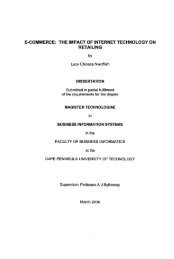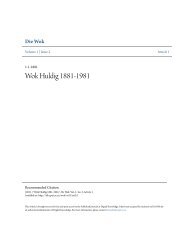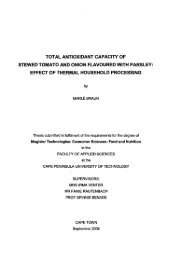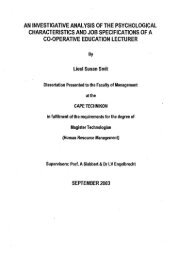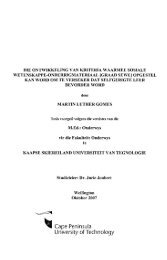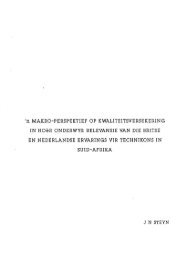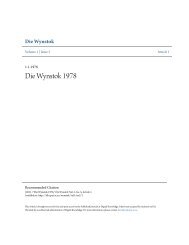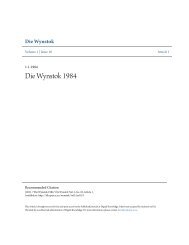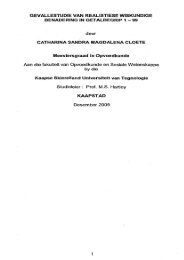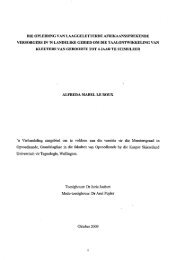the effect of the particle size distribution on non-newtonian turbulent ...
the effect of the particle size distribution on non-newtonian turbulent ...
the effect of the particle size distribution on non-newtonian turbulent ...
You also want an ePaper? Increase the reach of your titles
YUMPU automatically turns print PDFs into web optimized ePapers that Google loves.
Chapter 5 Discussi<strong>on</strong> Page 5.6<br />
The number <str<strong>on</strong>g>of</str<strong>on</strong>g><str<strong>on</strong>g>particle</str<strong>on</strong>g>s per square meter for <str<strong>on</strong>g>the</str<strong>on</strong>g> mixture I test sets were c<strong>on</strong>siderably lower<br />
than <str<strong>on</strong>g>the</str<strong>on</strong>g> o<str<strong>on</strong>g>the</str<strong>on</strong>g>r test sets. This could be due to <str<strong>on</strong>g>the</str<strong>on</strong>g> fact that <str<strong>on</strong>g>the</str<strong>on</strong>g> viscous sub-layer thickness <str<strong>on</strong>g>of</str<strong>on</strong>g><br />
mixture I is relatively large compared to <str<strong>on</strong>g>the</str<strong>on</strong>g> kaolin and mixture 2 viscous sub-layer thickness<br />
and hence <str<strong>on</strong>g>the</str<strong>on</strong>g> percentage <str<strong>on</strong>g>of</str<strong>on</strong>g> large <str<strong>on</strong>g>particle</str<strong>on</strong>g>s present (due to <str<strong>on</strong>g>the</str<strong>on</strong>g> definiti<strong>on</strong> <str<strong>on</strong>g>of</str<strong>on</strong>g> a large <str<strong>on</strong>g>particle</str<strong>on</strong>g>)<br />
is low. It is interesting to note that number <str<strong>on</strong>g>of</str<strong>on</strong>g><str<strong>on</strong>g>particle</str<strong>on</strong>g>s per meter square <str<strong>on</strong>g>of</str<strong>on</strong>g> viscous sub-layer<br />
for <str<strong>on</strong>g>the</str<strong>on</strong>g> 25mm, 80mm, 150mm and 200mm pipelines is <str<strong>on</strong>g>the</str<strong>on</strong>g> same per test set due to <str<strong>on</strong>g>the</str<strong>on</strong>g><br />
number c<strong>on</strong>centrati<strong>on</strong> being independent <str<strong>on</strong>g>of</str<strong>on</strong>g> diameter.<br />
What would streng<str<strong>on</strong>g>the</str<strong>on</strong>g>n <str<strong>on</strong>g>the</str<strong>on</strong>g> case bf <str<strong>on</strong>g>particle</str<strong>on</strong>g> roughness turbulence is if <str<strong>on</strong>g>the</str<strong>on</strong>g> <strong>turbulent</strong> flow<br />
headloss in a vertical test secti<strong>on</strong> was found to be <str<strong>on</strong>g>the</str<strong>on</strong>g> same as <str<strong>on</strong>g>the</str<strong>on</strong>g> horiz<strong>on</strong>tal. There is<br />
evidence to suggest (eg. Maude & Whitmore, 1956, Wils<strong>on</strong>, 1996) that <str<strong>on</strong>g>particle</str<strong>on</strong>g>s have a<br />
tendency in vertical pipes to move inward away from <str<strong>on</strong>g>the</str<strong>on</strong>g> wall (ie. away from <str<strong>on</strong>g>the</str<strong>on</strong>g> viscous<br />
sub-layer). If this is indeed <str<strong>on</strong>g>the</str<strong>on</strong>g> case <str<strong>on</strong>g>the</str<strong>on</strong>g>n it could affect <str<strong>on</strong>g>the</str<strong>on</strong>g> <str<strong>on</strong>g>effect</str<strong>on</strong>g>iveness <str<strong>on</strong>g>of</str<strong>on</strong>g> <str<strong>on</strong>g>the</str<strong>on</strong>g> <str<strong>on</strong>g>particle</str<strong>on</strong>g><br />
roughness <str<strong>on</strong>g>effect</str<strong>on</strong>g>. Fur<str<strong>on</strong>g>the</str<strong>on</strong>g>r test should be c<strong>on</strong>ducted to c<strong>on</strong>firm if <str<strong>on</strong>g>the</str<strong>on</strong>g> horiz<strong>on</strong>tal headloss and<br />
vertical headloss are in agreement.<br />
5.6 INFLUE."iCE OF PARTICLE SIZE<br />
In Chapter 4, it was stated that an increase in wall shear stress with an increase in<br />
c<strong>on</strong>centrati<strong>on</strong> for <str<strong>on</strong>g>the</str<strong>on</strong>g> 150mm pipeline tests" for mixture 2 was due to an increase in <str<strong>on</strong>g>the</str<strong>on</strong>g><br />
representative <str<strong>on</strong>g>particle</str<strong>on</strong>g> <str<strong>on</strong>g>size</str<strong>on</strong>g>. The d S5 <str<strong>on</strong>g>particle</str<strong>on</strong>g> <str<strong>on</strong>g>size</str<strong>on</strong>g>s for <str<strong>on</strong>g>the</str<strong>on</strong>g> three 150mm pipeline tests were<br />
l37/tm, 158j.Lm and 170j.Lm and <str<strong>on</strong>g>the</str<strong>on</strong>g> increase in wall shear stress can clearly be seen in Figure<br />
4.21. Slatter's model best predicted <str<strong>on</strong>g>the</str<strong>on</strong>g> <strong>turbulent</strong> flow data for mixture 2 as it is based <strong>on</strong><br />
<str<strong>on</strong>g>the</str<strong>on</strong>g> <str<strong>on</strong>g>particle</str<strong>on</strong>g> roughness <str<strong>on</strong>g>effect</str<strong>on</strong>g> and is able to account for <str<strong>on</strong>g>the</str<strong>on</strong>g> increase in wall shear stress. The<br />
greater <str<strong>on</strong>g>the</str<strong>on</strong>g> representative <str<strong>on</strong>g>particle</str<strong>on</strong>g> <str<strong>on</strong>g>size</str<strong>on</strong>g> <str<strong>on</strong>g>of</str<strong>on</strong>g> a homogeneous slurry <str<strong>on</strong>g>the</str<strong>on</strong>g> greater will be <str<strong>on</strong>g>the</str<strong>on</strong>g><br />
Increase in <str<strong>on</strong>g>the</str<strong>on</strong>g> wall shear stress and <str<strong>on</strong>g>the</str<strong>on</strong>g> greater will be <str<strong>on</strong>g>the</str<strong>on</strong>g> possibility <str<strong>on</strong>g>of</str<strong>on</strong>g> <str<strong>on</strong>g>the</str<strong>on</strong>g> o<str<strong>on</strong>g>the</str<strong>on</strong>g>r <str<strong>on</strong>g>the</str<strong>on</strong>g>oretical<br />
models being unable to predict <str<strong>on</strong>g>the</str<strong>on</strong>g> <strong>turbulent</strong> flow data.<br />
HOwever, this phenomen<strong>on</strong> could also be ascribed to <str<strong>on</strong>g>the</str<strong>on</strong>g> fact that <str<strong>on</strong>g>the</str<strong>on</strong>g>re is an increase in <str<strong>on</strong>g>the</str<strong>on</strong>g><br />
rheology and <str<strong>on</strong>g>the</str<strong>on</strong>g> density <str<strong>on</strong>g>of</str<strong>on</strong>g> <str<strong>on</strong>g>the</str<strong>on</strong>g> slurry. To c<strong>on</strong>firm that <str<strong>on</strong>g>the</str<strong>on</strong>g> increase in wall shear stress is<br />
Jue to an increase in <str<strong>on</strong>g>the</str<strong>on</strong>g> <str<strong>on</strong>g>particle</str<strong>on</strong>g> <str<strong>on</strong>g>size</str<strong>on</strong>g>, <str<strong>on</strong>g>the</str<strong>on</strong>g> sensitivity to changes in wall shear stress due to




